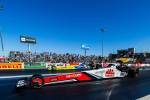NASCAR stays proactive with changes to formats
NASCAR didn’t just make some tweaks to its playoff and qualifying formats during the offseason.
The organization overhauled both, issuing announcements about each change about a week apart in late January.
NASCAR, however, did more than make announcements. The organization made a statement.
This is a governing body, it essentially said, that is more than willing to shake up the status quo so that the sport moves forward against ever-increasing competition for the entertainment dollar in what remains a tough economy.
No one at NASCAR might put the reason for such moves in those exact terms, but no executive in any sport wants to cede ground in trying to capture public attention.
“We’ve been on a fast track to make some changes that enhance competition, give the fans at the racetracks more content and try to improve the product,” said Robin Pemberton, NASCAR vice president for competition and development. “Both of these changes, I think, meet our expectation.”
NASCAR made several notable changes to the Chase for the Sprint Cup. The field increases from 12 to 16 drivers in what will be an elimination format. Under the old format, all 12 drivers were eligible for the series championship all the way to the end, provided they were still mathematically in the running.
The first three races in the new playoff system whittle the field to 12 drivers, the next three to eight and the following three to four. Those final four racers compete for the series championship on Nov. 16 at Homestead-Miami.
Determining the top 16 also no longer will be strictly on points. The top 15 drivers in victories over the first 26 races make the field, and the 16th spot will go to the leader in points without a win.
Because of the added emphasis on winning, that makes races such as Sunday’s Kobalt 400 at Las Vegas Motor Speedway even more important. The winner takes a major step toward making the Chase.
There was no crystallizing moment, Pemberton said, when NASCAR decided to make changes to the Chase, saying it was a process going back several years. NASCAR ran the idea of altering the format by race teams as well as fans in focus groups.
But a moment did come when NASCAR officials realized the time for moving forward with such a plan had come.
They had been disappointed by the lack of drama in late-season races, but saw in 2011 what a showdown could mean to the sport when Tony Stewart rallied to beat Carl Edwards in the final event to capture the Sprint Cup title. NASCAR received a lot of attention for Stewart’s daring comeback after twice being in the back of the field, giving the sport the satisfying ending officials badly wanted.
“Trying to generate that feeling at the end of the year, we tried to build on that,” Pemberton said. “I think (that race) confirmed that you need a title race in the last race of the season (which) was better for everybody.”
The qualifying format also will be strikingly different, with NASCAR switching to an elimination system favored by IndyCar and Formula One. NASCAR had used single-car qualifying to set its field, but now every car will take to the track in more of a race-like atmosphere.
Las Vegas Motor Speedway will be the first site to use the new system for tracks at least 1.25 miles long. Friday’s qualifying will consist of three segments — a 25-minute session to pare the number to the top 24 cars, and then 10- and five-minute runs to finalize the field.
Shorter tracks will use two qualifying segments.
“We wanted to get something that’s a little more exciting, something that (the tracks) could sell,” Pemberton said. “But there are advantages to it also. When you look across the entire season, there are some times that when we qualified, these formats would take in excess of three hours if you’re at a superspeedway.”
Contact reporter Mark Anderson at manderson@reviewjournal.com or 702-387-2914. Follow him on Twitter @markanderson65.























